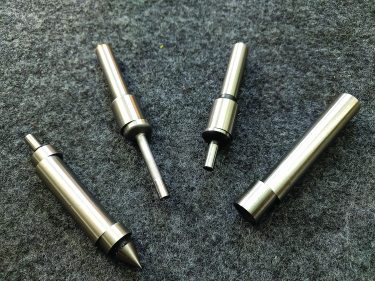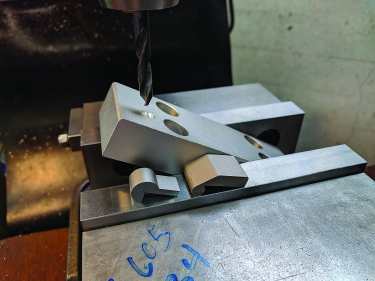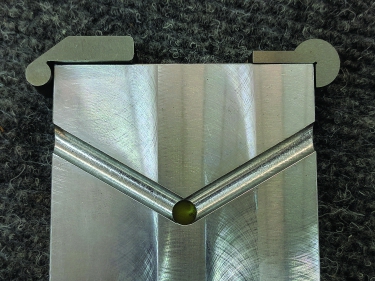Traditional edge finding on a milling machine is pretty straightforward. Edge finding establishes the milling machine’s measuring coordinate system relative to the newly inserted workpiece so the user can perform accurate work. “Picking up an edge” is the general shop description of this operation.
There is an array of mechanical and electronic tools for picking up orthogonal surfaces on a machine tool. Wiggler-type edge finders are common ones (Figure 1). They have a spring-loaded eccentric tip of known size that rotates closer and closer to concentric until it becomes perfectly tangent with the edge under interrogation.

Figure 1. Wiggler-type edge finders have a spring-loaded eccentric tip of known size that rotates closer and closer to concentric until it becomes perfectly tangent with the edge under interrogation. All images: T. Lipton.
Some shop workers debate the proper method to read a wiggler edge finder. The two competing methods are when the edge finder eccentric jumps sideways under the tiniest axis advancement and when, just prior to jumping, both the shank and eccentric are visually running perfectly concentric. The difference in accuracy for each method is very small, with several other factors contributing to the overall accuracy of the edge pickup.
When performing toolmaking or repair work on a milling machine, it is common to establish an accurate datum on nonorthogonal faces or edges of angled surfaces. The traditional wiggler edge finder does not work well for angular situations.
Kern Tool and Pyano, however, developed clever solutions (Figure 2). The round sections of these wire EDM-cut edge finders have a precisely known size. Both can be made from prehardened tool steel for long life and durability. The right-angle model (Kern Tool sine center) has two flat datum surfaces that intersect at the exact center of the round boss.

Figure 2. A Kern-type edge finder (left on surface in front of angled workpiece) and Pyano-type edge finder can be made for angular applications. Note the tiny corner relief at the center of each to clear any burrs on the workpiece.
With a standard wiggler edge finder and a Kern or Pyano-type finder, you can now pick up the precise corner on an angled setup using the standard edge-finding technique. The Kern edge finder also allows calibrating the vertical height of the corner under interrogation by touching off on the top of the known diameter, say, 0.500" (12.7mm), and subtracting one half its diameter. The Kern style works best on acute angles or perpendicular corners.
The Pyano-style edge finder sets the small-diameter circular section exactly tangent to the two intersecting surfaces. Using a little shop math, you can pick up the corner on almost any angle of intersecting surfaces. With the Pyano style, the intersecting surfaces can be open (obtuse) and you still can establish an accurate corner pickup. Both edge finders can establish an accurate corner reference, even if the corner has a small radius or chamfer.
A common application of when you would use such a corner-pickup device is with multiple intersecting holes (Figure 3). The setup and data accuracies are key to generating good results. Combined angular setups are typically sensitive to small positioning and setup errors.

Figure 3. A common application for a Pyano or Kern edge finder is with multiple intersecting holes.
Figure 3 shows three holes intersecting in one location, with the center hole forming a smooth tangent radius between the two angled ports. This is possible only if the three different setups required for this example are performed carefully and accurately.
The angle of the working surface must be known or set accurately with the Pyano edge finder. Because its tangent position varies with the angle of the work surface, that angle needs to be known with some certainty to determine the exact corner position. This is usually not a problem because the angle is deliberately established as part of the work setup. It should be noted that either of these edge finders works for round or circular work.
Unfortunately, these clever edge finders are not commercially available, to my knowledge, but both are easy to make on a wire EDM. The able folks who inhabit machine shops can even make them without a wire EDM.
The Kern-type edge finder can be made from an accurately sized round with a 90° groove machined or ground along its axis. Take care when cutting the groove to the precise centerline. In addition, make sure to add a small relief at the centerline to allow burrs on the part to clear.
The Pyano-type edge finder can be made with a small piece of steel ground flat and an accurately sized dowel or gage pin soldered or glued with industrial cyanoacrylate, such as Locktite 380. Try them; you’ll like them.
Related Glossary Terms
- edge finder
edge finder
Gage mounted in the spindle of a vertical mill and used, while rotating, to find the center of a part relative to the toolholder.
- electrical-discharge machining ( EDM)
electrical-discharge machining ( EDM)
Process that vaporizes conductive materials by controlled application of pulsed electrical current that flows between a workpiece and electrode (tool) in a dielectric fluid. Permits machining shapes to tight accuracies without the internal stresses conventional machining often generates. Useful in diemaking.
- flat ( screw flat)
flat ( screw flat)
Flat surface machined into the shank of a cutting tool for enhanced holding of the tool.
- gang cutting ( milling)
gang cutting ( milling)
Machining with several cutters mounted on a single arbor, generally for simultaneous cutting.
- milling
milling
Machining operation in which metal or other material is removed by applying power to a rotating cutter. In vertical milling, the cutting tool is mounted vertically on the spindle. In horizontal milling, the cutting tool is mounted horizontally, either directly on the spindle or on an arbor. Horizontal milling is further broken down into conventional milling, where the cutter rotates opposite the direction of feed, or “up” into the workpiece; and climb milling, where the cutter rotates in the direction of feed, or “down” into the workpiece. Milling operations include plane or surface milling, endmilling, facemilling, angle milling, form milling and profiling.
- milling machine ( mill)
milling machine ( mill)
Runs endmills and arbor-mounted milling cutters. Features include a head with a spindle that drives the cutters; a column, knee and table that provide motion in the three Cartesian axes; and a base that supports the components and houses the cutting-fluid pump and reservoir. The work is mounted on the table and fed into the rotating cutter or endmill to accomplish the milling steps; vertical milling machines also feed endmills into the work by means of a spindle-mounted quill. Models range from small manual machines to big bed-type and duplex mills. All take one of three basic forms: vertical, horizontal or convertible horizontal/vertical. Vertical machines may be knee-type (the table is mounted on a knee that can be elevated) or bed-type (the table is securely supported and only moves horizontally). In general, horizontal machines are bigger and more powerful, while vertical machines are lighter but more versatile and easier to set up and operate.
- relief
relief
Space provided behind the cutting edges to prevent rubbing. Sometimes called primary relief. Secondary relief provides additional space behind primary relief. Relief on end teeth is axial relief; relief on side teeth is peripheral relief.
- shank
shank
Main body of a tool; the portion of a drill or similar end-held tool that fits into a collet, chuck or similar mounting device.
- wire EDM
wire EDM
Process similar to ram electrical-discharge machining except a small-diameter copper or brass wire is used as a traveling electrode. Usually used in conjunction with a CNC and only works when a part is to be cut completely through. A common analogy is wire electrical-discharge machining is like an ultraprecise, electrical, contour-sawing operation.


